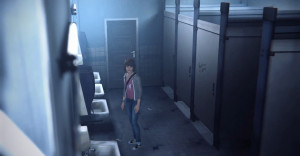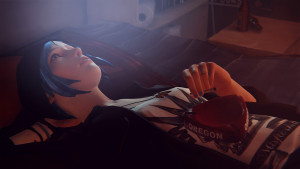The end of January brought Life is Strange to my television, giving me a reason to dust the screen and the Xbox 360 sitting placidly beside it. This new choice-driven adventure perhaps made a bit of a jealous ex-girlfriend out of Telltale. As if our relationship was not already rocky, I was left feeling slighted by Game of Thrones: Lost Lords‘s dated engine and shoddy performance, as though it were an act meant to punish me for hanging out with another game. Well, since I am already in the doghouse, I might as well see just how much more hot water I can get myself into by comparing them in some kind of pageant that exists only in my head.
Right off the bat, I realized I was not the audience Life is Strange was intended for, probably because I am a cranky old man who does not understand these damned kids and their music. If there is one thing I hate in a story, it is any characters that remind me of a Facebook post from that guy who wastes everyone’s time quoting song lyrics to appear deeply emotional and so utterly conflicted by life. I was not exactly prepared to encounter ‘kids these days’ in a game, but that I hate it might mean they captured things rather flawlessly. In Teen Angst is Strange, the player is thrust into the world of an eighteen year old girl in a hoodie, snapping away her interest in photography with a Polaroid camera, like any other self-proclaimed hipster. Of course, this is all intentional, meant to be a tongue-in-cheek commentary since her school of choice is populated with just about every stereotype from Mean Girls, which, to be fair, happens to be a pretty funny movie. Yet, this might be a good thing.
Our photographer hipsterette, sporting the name Max like a champ, turns out to have some temporal tweaking abilities in that she can rewind time. This is ultimately what got me interested in the game, and ultimately what may be the very factor that reverses my interest in it. When I play other games where choice is a decidedly deciding factor, I often spend unmentionable amounts of time wondering how the story would be going if I had done things different. Life is Strange seemed to promise something I had always wanted; the ability to go back and reverse a decision. As it turns out, I could not have been more wrong in my desire for such an option.
My decisions in Life is Strange feel less meaningful, though I am still trying to determine if that has to do with how the time mechanic is being handled, as opposed to the old way of making a choice, then dealing with the nagging doubt that perhaps the wrong path was set upon without any further information to go on. The latter (the Ignorance Method) quite possibly added to these games for me by creating that instant doubt, whereas the former (The Semi-Informed Method) is allowing me to make a weighted decision while taking away a tiny bit of the surprise. What is really interesting to me is that I may be in for an even bigger twist than I am giving the game credit for. The thing is that the player only gets to see the immediate consequences of a choice when time reversal is used. Typically, nothing else is indicated, save for an ominous message stating “this action will have consequences.”
If I hold to my complaints about the story, and the time mechanic proves to be ripples in a vast pond of possibilities, I may very well end up blown away by how the writers can weave an intricate and compelling story into this game. What I suppose I am saying is that I see the possibility for this series to be something great, and my initial hang-ups about it might actually be setting me up for a massive change of heart. If that was a writer intention, then bravo. After all, the series is only on the first episode, and while the camera work (the actual game camera, not the dumb Polaroid) often makes me think I have been drinking heavily, I will be giving the next episode a chance when it drops.
After showering, so as to remove any scent of a competing game, I returned to the finicky bed of Telltale Games. GoT:Lost Lords opened with all the usual series fanfare, showing me that mechanized map of Westeros and its distant lands, then it suddenly stopped opening. Oh, pardon me; the audio worked fine. I was presented with a black screen, and while I patiently waited for the game engine to recover, I was missing dialogue choices to things that seemed rather important, considering the game drops the player into Asher Forrester’s suave boots. No big deal, I have dealt with glitchy games in the past, so I simply restarted. The second time around, I managed to get short spurts of visuals before they would freeze at crucial moments, considering I let poor Asher get skewered three times before the game would let me see what button I was supposed to press to prevent sharp metal things from entering his chest.
This was bothersome and persistent through the entirety of the game, and shows just how piss poor the game engine is. What is arguably the oddest thing about my experience with these first two episodes is that in the first one these hiccups did not bother me as much. They were certainly there, though from what I recall, they were brief and typically unobtrusive, happening at moments where a few frames of jumpy or blank screens would not really matter. Was it luck? I honestly have no idea, as I can not begin to imagine would could possibly be different about the production between the first and second episode. Maybe there is something to be said about waiting for patches, but I did not do this for the first part of GoT, so that is likely not the case. Whatever happened, it made the game nearly impossible to enjoy. Yes, nearly. In the end, it is a Game of Thrones thing, and I am a slut who can not get enough of the franchise.
As both games progress, I will be reporting back. In the meantime, if anyone needs me, I will be huddled under a warm blanket with Bravely Default to distract me from this bone-biting Midwestern Winter chill.


